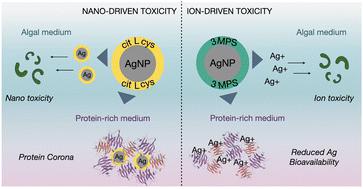当前位置:
X-MOL 学术
›
Environ. Sci.: Nano
›
论文详情
Our official English website, www.x-mol.net, welcomes your feedback! (Note: you will need to create a separate account there.)
Capping drives the behavior, dissolution and (eco)toxicity of silver nanoparticles towards microorganisms and mammalian cells
Environmental Science: Nano ( IF 7.3 ) Pub Date : 2024-03-12 , DOI: 10.1039/d4en00063c Arianna Bellingeri 1, 2 , Nina Bono 3 , Iole Venditti 4 , Federica Bertelà 4 , Luca Burratti 4 , Claudia Faleri 5 , Giuseppe Protano 1 , Eugenio Paccagnini 5 , Pietro Lupetti 5 , Gabriele Candiani 3 , Ilaria Corsi 1, 2
Environmental Science: Nano ( IF 7.3 ) Pub Date : 2024-03-12 , DOI: 10.1039/d4en00063c Arianna Bellingeri 1, 2 , Nina Bono 3 , Iole Venditti 4 , Federica Bertelà 4 , Luca Burratti 4 , Claudia Faleri 5 , Giuseppe Protano 1 , Eugenio Paccagnini 5 , Pietro Lupetti 5 , Gabriele Candiani 3 , Ilaria Corsi 1, 2
Affiliation

|
Surface coating plays a fundamental role in driving silver nanoparticle (AgNP) toxicity towards cells, but no clarity exists on the mechanism behind it. AgNPs with two different capping agents, citrate and L-cysteine (citLcys) and sodium-3-mercapto-1-propanesulfonate (3MPS), developed as sensors for metal ions in water (e.g., Hg(II) and Ni(II)), were investigated in terms of (eco)toxicity towards bacteria (Escherichia coli), microalgae (Raphidocelis subcapitata and Phaeodactylum tricornutum) and mammalian cells (HeLa and L929). After 72 h of incubation, Ag ion dissolution in algal media was negligible (<1% of nominal AgNP concentration) for both batches. Suspension in protein-rich media showed the formation of a protein corona around AgNPcitLcys as opposed to AgNP3MPS, which was confirmed by dynamic light scattering (DLS) analysis, transmission electron microscopy (TEM) and one-dimensional polyacrylamide gel electrophoresis (1D-PAGE). Low toxicity was observed for both AgNPs towards microalgae (≥5 mg L−1) and E. coli (≥256 mg L−1) and no effect was observed on HeLa and L929 cells. However, the responses suggest that citLcys coating might trigger the onset of a nano-size related toxicity as opposed to 3MPS, whose toxicity mainly relies on dissolution. Our findings show how surface coating rules AgNP interaction with biomolecules and drives AgNP (eco)toxicity towards cells, thus influencing exposure outcome.
中文翻译:

封端驱动银纳米粒子对微生物和哺乳动物细胞的行为、溶解和(生态)毒性
表面涂层在银纳米颗粒(AgNP)对细胞产生毒性方面发挥着重要作用,但其背后的机制尚不清楚。含有两种不同封端剂(柠檬酸盐和L-半胱氨酸 (citLcys) 以及 3-巯基-1-丙磺酸钠 (3MPS))的 AgNP,开发用作水中金属离子(例如Hg( II ) 和 Ni( II ))的传感器,针对细菌(大肠杆菌)、微藻(Raphidocelis subcapitata和Phaeodactylum tricornutum)和哺乳动物细胞(HeLa 和 L929)的(生态)毒性进行了研究。孵育 72 小时后,两个批次的藻类介质中的银离子溶解量都可以忽略不计(< 标称 AgNP 浓度的 1%)。富含蛋白质的培养基中的悬浮液显示,与 AgNP3MPS 相比,AgNPcitLcys 周围形成了蛋白冠,这一点通过动态光散射 (DLS) 分析、透射电子显微镜 (TEM) 和一维聚丙烯酰胺凝胶电泳 (1D-PAGE) 得到证实。 AgNP 对微藻 (≥5 mg L -1 ) 和大肠杆菌(≥256 mg L -1 )的毒性均较低,且对 HeLa 和 L929 细胞没有影响。然而,反应表明,citLcys 涂层可能会引发纳米级相关毒性,而 3MPS 的毒性主要依赖于溶解。我们的研究结果表明,表面涂层如何控制 AgNP 与生物分子的相互作用,并驱动 AgNP 对细胞的(生态)毒性,从而影响暴露结果。
更新日期:2024-03-12
中文翻译:

封端驱动银纳米粒子对微生物和哺乳动物细胞的行为、溶解和(生态)毒性
表面涂层在银纳米颗粒(AgNP)对细胞产生毒性方面发挥着重要作用,但其背后的机制尚不清楚。含有两种不同封端剂(柠檬酸盐和L-半胱氨酸 (citLcys) 以及 3-巯基-1-丙磺酸钠 (3MPS))的 AgNP,开发用作水中金属离子(例如Hg( II ) 和 Ni( II ))的传感器,针对细菌(大肠杆菌)、微藻(Raphidocelis subcapitata和Phaeodactylum tricornutum)和哺乳动物细胞(HeLa 和 L929)的(生态)毒性进行了研究。孵育 72 小时后,两个批次的藻类介质中的银离子溶解量都可以忽略不计(< 标称 AgNP 浓度的 1%)。富含蛋白质的培养基中的悬浮液显示,与 AgNP3MPS 相比,AgNPcitLcys 周围形成了蛋白冠,这一点通过动态光散射 (DLS) 分析、透射电子显微镜 (TEM) 和一维聚丙烯酰胺凝胶电泳 (1D-PAGE) 得到证实。 AgNP 对微藻 (≥5 mg L -1 ) 和大肠杆菌(≥256 mg L -1 )的毒性均较低,且对 HeLa 和 L929 细胞没有影响。然而,反应表明,citLcys 涂层可能会引发纳米级相关毒性,而 3MPS 的毒性主要依赖于溶解。我们的研究结果表明,表面涂层如何控制 AgNP 与生物分子的相互作用,并驱动 AgNP 对细胞的(生态)毒性,从而影响暴露结果。



























 京公网安备 11010802027423号
京公网安备 11010802027423号